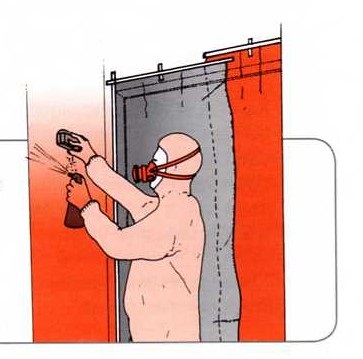Safe Renovation Practices
Protecting yourself and others from hazards is easy if you use the following steps:
- Identify hazards
- Prepare the work area
- Use safe work practices
- Clean up properly
If possible plan to have pregnant women, children and pets move out or away from the work areas until clean-up is finished. Also, tell your neighbours about the renovations so they can take steps to protect themselves if necessary.
1. Identify Hazards
The most accurate way to find out if there are hazardous materials present is to have them tested by a qualified specialist.
- Carefully examine the worksite for materials (including dust or soil) that could contain hazardous chemicals. It may be difficult to identify hazards by eye alone.
- Seek professional advice or get suspect materials tested if unsure. If in doubt, assume a hazard is present and take the appropriate precautions.
2. Prepare the Work Area
Outside
- Lay plastic sheeting under the work area to prevent dust contaminating the ground. Move children's play equipment away from the work area and keep kids and pets away until after clean up.
- Close windows and doors and seal vents to stop dust going into your house.
- Ask neighbours to do the same. Seal off other places where dust can get in such as under doors.
Inside
- Seal the work area off from other rooms inside the house to prevent contamination of non-work areas. Close doors and use tape and sheets of plastic. Tape plastic over the floor. Cover vents, air conditioning and central heating ducts.
- If using VOCs (paint, glues etc) open outside windows and doors for ventilation to prevent fumes from concentrating in the work area.
- Remove soft furnishings, rugs and curtains from the work area or seal them in plastic if they can't be moved.
3. Work Safely
- Don't eat, drink or smoke in the work area as you may inhale or eat the dust. Wash your hands and face with soap and water before meal breaks and when finished work for the day.
- Use practices that minimise dust and fumes.
For example:
- use paint strippers rather than sanding or abrading the surface (strippers can be dangerous if used improperly - follow safety information carefully);
- gently remove and stack demolition materials (no smashing or throwing);
- use non-powered hand tools if possible as they generate less dust;
- Use a pump spray pack to lightly dampen and keep down the dust. Be careful using water around electrical fittings.
- Use the appropriate Australian Standard (AS) approved respirator or dust mask recommended for the job (see manufacturer's information when selecting and using this equipment). Also wear a hat, gloves, coveralls, and safety glasses or goggles to protect the eyes.
- Keep dust within the work area. It can be carried out on shoes, clothing, tools, demolition materials etc. Never shake off dust cloths to clean them - instead clean them with a High Efficiencey Particulate Air (HEPA) industrial vacuum cleaner.
Note: It is illegal to water-blast asbestos cement materials.
When shopping for safety gear look for the Australian Standard Logo.
4. Clean Up Properly
- Clean up the work site at the end of each day or work session. Remove waste from the work area immediately.
- Avoid dry sweeping which stirs up dust. Dampen dust with a 'mist' of water from a spray pump pack. Wash plastic sheeting using sponges and buckets. Waste water not containing VOC washes should be poured down the sewer, not stormwater drains or on the ground.
- Wrap waste materials in plastic and tape while still in the work area. Clearly label lead and asbestos waste.
- Dispose of waste at an approved waste facility (see environmental section). It is illegal to put asbestos in domestic rubbish bins.
- Remove contaminated clothes in the work area and wash yourself. Wash work clothes separately from non-work (family) clothes. Rinse out the machine when finished.
